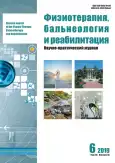Новый комбинированный метод лечения инволютивных изменений периорбитальной области
- Авторы: Халиуллин Р.И.1
-
Учреждения:
- АО «Клиника Екатерининская»
- Выпуск: Том 18, № 6 (2019)
- Страницы: 386-391
- Раздел: Оригинальные исследования
- URL: https://journal-vniispk.ru/1681-3456/article/view/70578
- DOI: https://doi.org/10.17816/1681-3456-2019-18-6-386-391
- ID: 70578
Цитировать
Полный текст
Аннотация
Обоснование. К решению проблемы коррекции инволютивных изменений периорбитальной области необходимо подходить с позиции мультидисциплинарного подхода, поскольку в этой локализации возможно возникновение обширного спектра проблем, которые требуют решения. Стандартом для коррекции возрастных изменений уже много лет являются методы лазеротерапии. Однако многие вопросы комбинированных методов остаются открытыми, поэтому поиск и разработка наиболее эффективных протоколов их использования представляют собой актуальные задачи современной медицины.
Цель исследования: на основании изучения результатов клинической эффективности и с учетом показателей качественных характеристик кожи, а также микроциркуляции разработать комбинированный метод коррекции инволютивных изменений кожи в периорбитальной области у пациентов молодого и среднего возраста с использованием фракционного Nd:YAG- и СО2-лазера в сочетании с нижней трансконъюнктивальной блефаропластикой.
Материал и методы. В исследовании приняли участие 108 пациентов с инволютивными изменениями кожи нижнего века. В зависимости от способа лечения пациенты были разделены на группы. В исследовании были использованы специальные методы: исследование качественных характеристик кожи (кутометрия, ТЭВА-метрия, корнеометрия), микроциркуляторных процессов с помощью лазерной флоуметрии.
Результаты. Эффективность разработанного комбинированного метода основывается на выраженном положительном влиянии на активные и пассивные механизмы гемодинамики на всех уровнях микроциркуляторного русла, что подтверждается увеличением интегрального показателя микроциркуляции на 45,92% против 26,35% и 5,77% в группах сравнения, при этом коэффициент вариации показателя микроциркуляции повысился на 33,02% против 24,19% и 6,46% после применения составляющих метода. Использование комбинированного метода лечения приводит к восстановлению качественных характеристик кожи: показатель увлажненности увеличился на 27% (р < 0,05) по сравнению с 14,1%, 7,8% в 1-й и 2-й группах соответственно, показатель трансэпидермальной потери воды уменьшился на 47% (р < 0,05) (по сравнению с 35%, 12,7% в 1-й и 2-й группах соответственно), показатель эластичности Ua/Uf увеличился на 23,2% (р < 0,05) (по сравнению с 18,4%, 16,4% в 1-й и 2-й группах соответственно).
Заключение. На основании проведенного исследования можно сделать вывод, что разработанный комбинированный метод лечения является высоко эффективным.
Полный текст
Открыть статью на сайте журналаОб авторах
Рустам Ильясович Халиуллин
АО «Клиника Екатерининская»
Автор, ответственный за переписку.
Email: rustam.iliasovich@gmail.com
ORCID iD: 0000-0002-6381-2909
Россия, Краснодар
Список литературы
- Kim M., Park H.J. Molecular Mechanisms of Skin Aging and Rejuvenation. In Molecular Mechanisms of the Aging Process and Rejuvenation. Manila: Tech, 2016.
- Озёрская О.С. Косметология. СПб.: ОАО «Издательско-полиграфическое предприятие «Искусство России», 2006. 528 с.
- Аравийская Е.Р., Соколовский Е.В. Руководство по дерматокосметологии. СПб.: Фолиант, 2008. 416 с.
- Эрнандес Е.И. Современные пилинги: химический пилинг, лазерная шлифовка, механическая дермабразия, плазменная шлифовка. 2-е изд., доп. М.: Изд. дом «Косметика и Медицина», 2011. 159 с.
- Стенько А.Г., Талыбова А.М., Чайковская Е.А., Круглова Л.С. Коррекция рубцов постакне: применение коньюгированной гиалуронидазы в виде монотерапии и в комбинации с лазеротерапией // Кремлевская медицина. Клинический вестник. 2018. № 2. С. 154–159.
- Chen K., Ka-Wai Tam, I-Fan Chen, et al. A systematic review of comparative studies of CO2 and erbium: YAG lasers in resurfacing facial rhytides (wrinkles) // Journal of Cosmetic and Laser Therapy. 2017. № 19(4). doi: 10.1080/14764172.2017.1288261.
- Голдберг Д.Д. Лазеро- и светолечение / пер. с англ. М.: Рид Элсивер, 2010. Т. 2. 216 с.
- Круглова Л.С., Шептий О.В., Жукова О.В. Современный взгляд на фототехнологии при фотоиндуцированном повреждении и хроностарении кожи // Физиотерапевт. 2014. № 4. С. 51–63.
Дополнительные файлы










